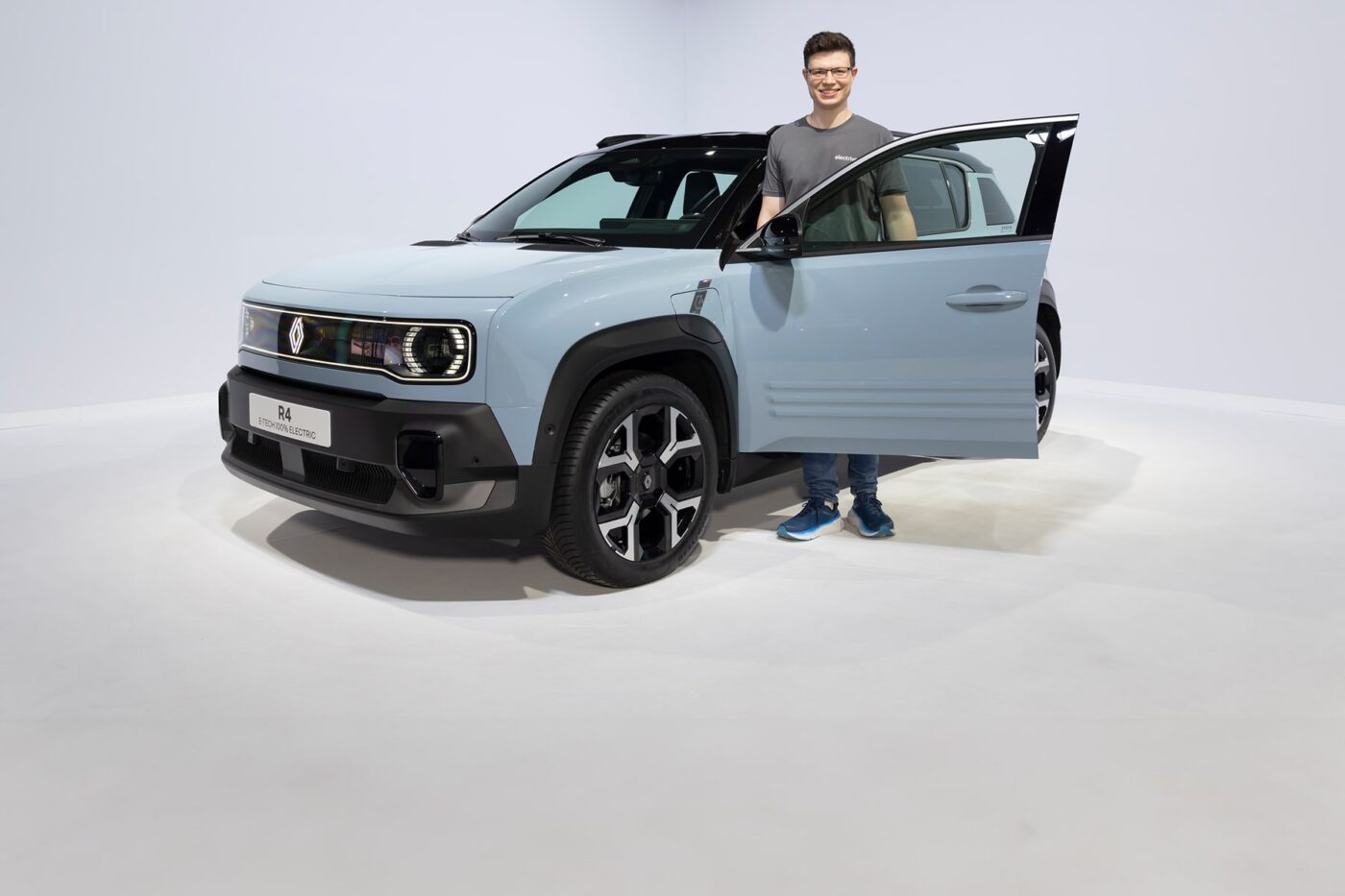
Taking a seat in the Renault 4 E-Tech: more than just retro?
VW brought back the original camper van with an electric motor, Citroen electrified the boxy 2CV, and Renault has launched a whole range of retro BEVs with the Twingo, R5 and now the R4. Old Renault 4s in cool paint finishes and unique shapes will also be on display at the premiere in Paris. We travelled there with a “not-another-retro-car” attitude and were pleasantly surprised by the EV, which is far more than the sum of its classic car references.
Successful design
It doesn’t look as retro as Renault makes its latest electric car out to be. It borrows individual design elements from its namesake, but still has its own unique look.
The core elements taken from the old R4 are the angular radiator grille, which runs across the entire front and surrounds the round Matrix LED headlights, as well as a third window at the rear instead of the massive C-pillars that are widely used today and the rather angular shape in general.
The gigantic wheels are completely different, making the new R4 look like a giant SUV – which, at 4.14 metres long and 1.80 metres wide, it definitely is not. The French national colours are a must so everyone knows where the car comes from. “100% electric and 100% French” is how Renault describes it; the car is built in Maubeuge near the Belgian border. This car is indeed typically French in many ways, which could perhaps prove to be a competitive advantage.
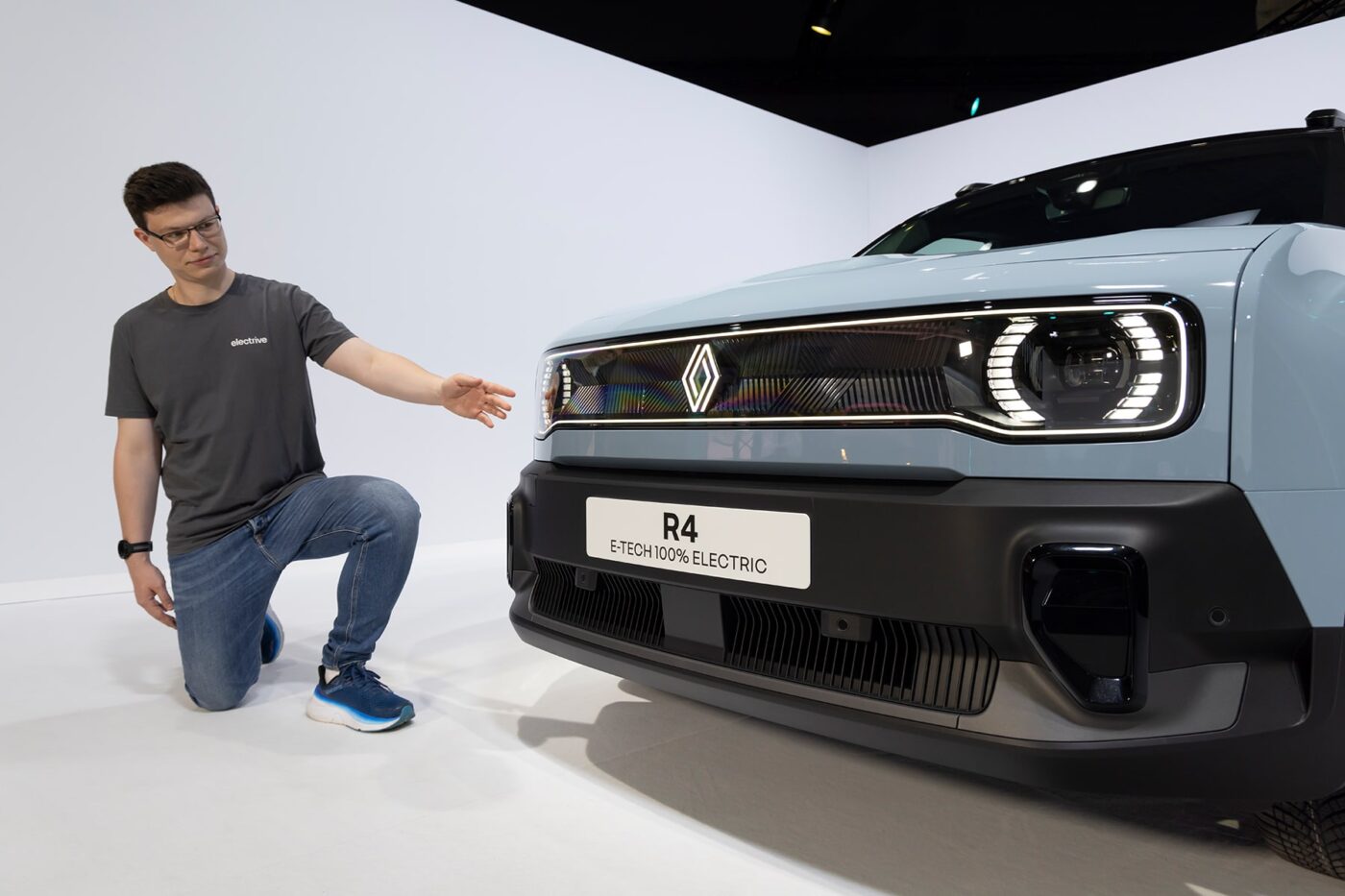
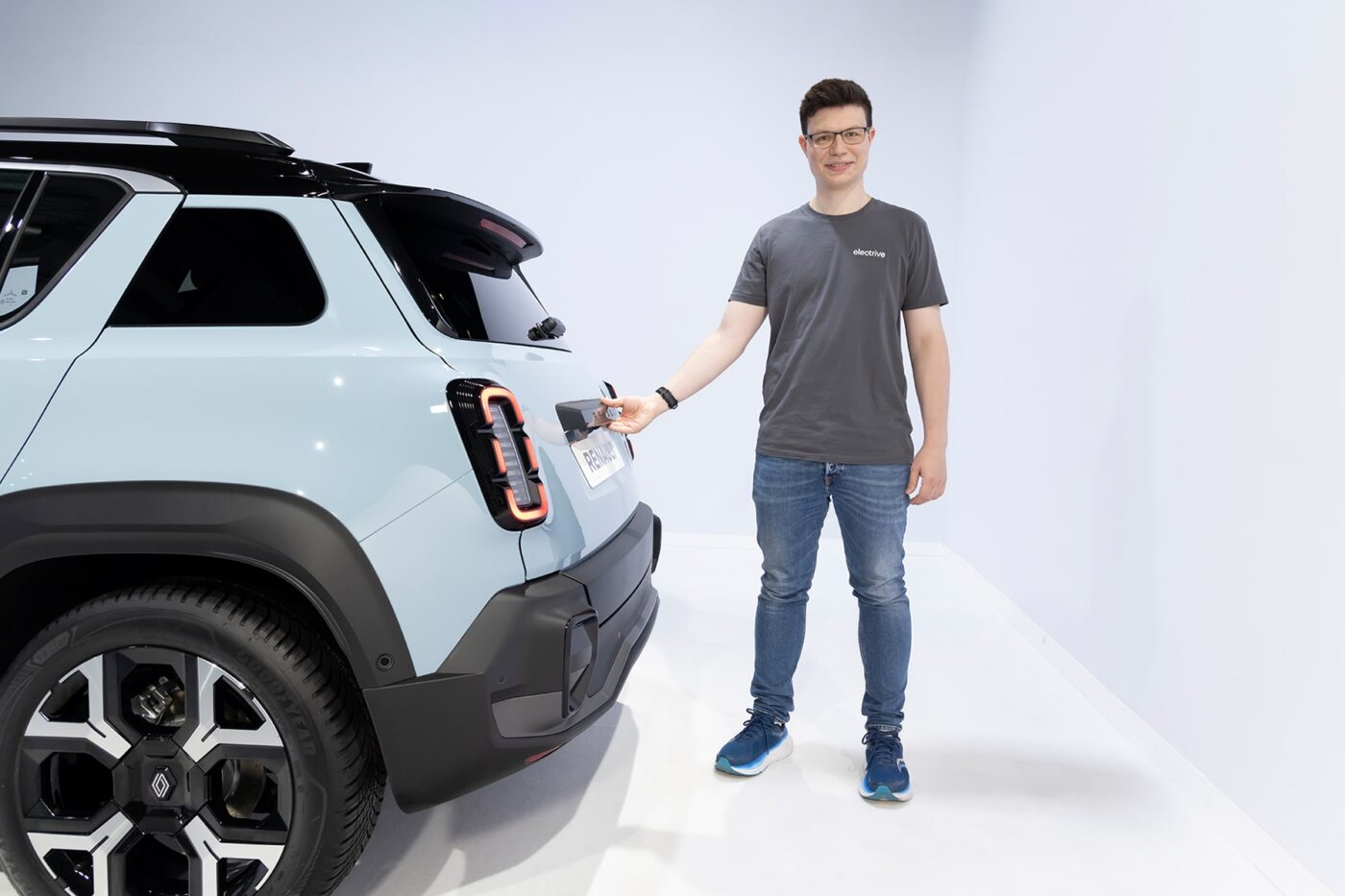
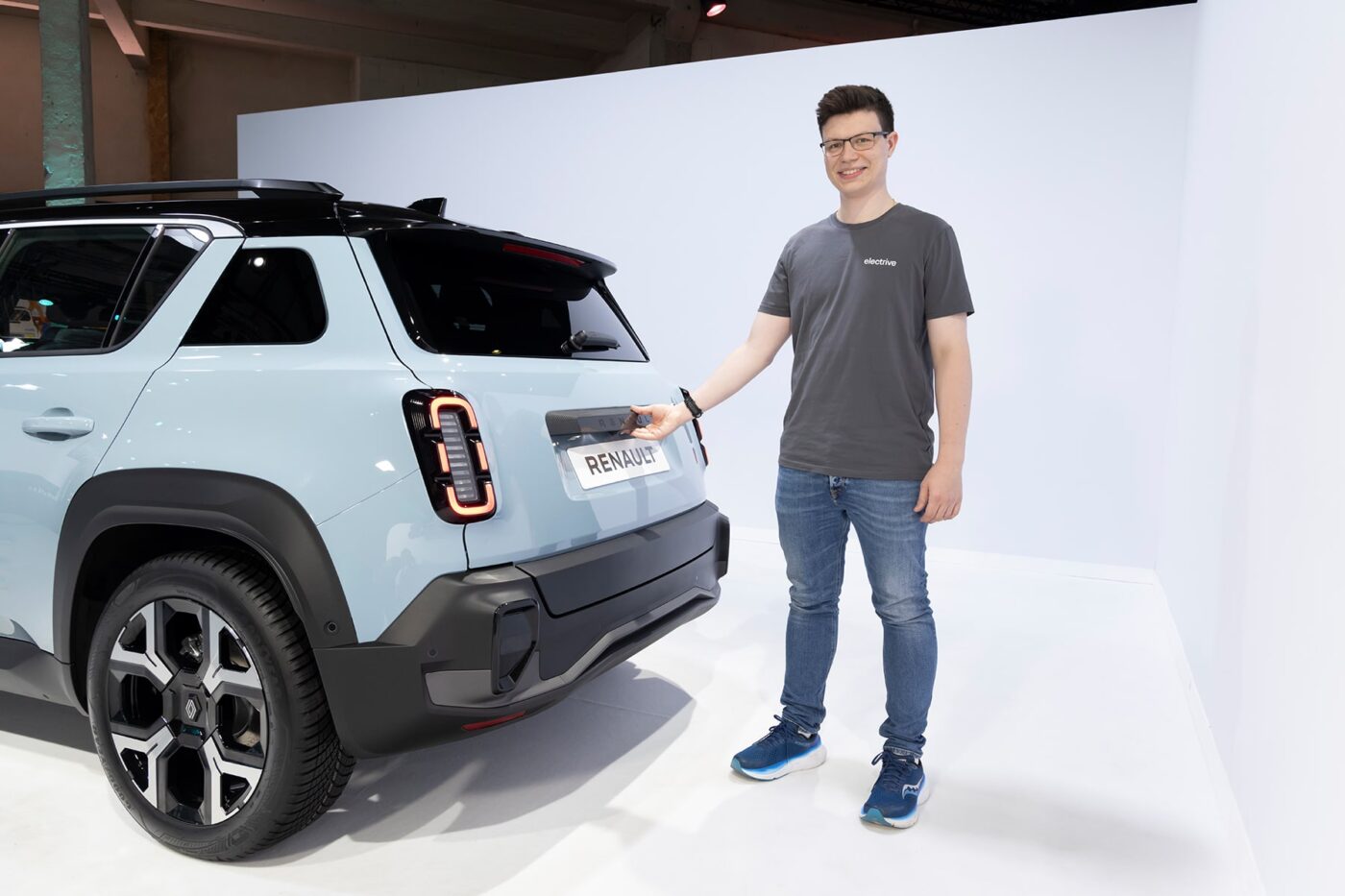
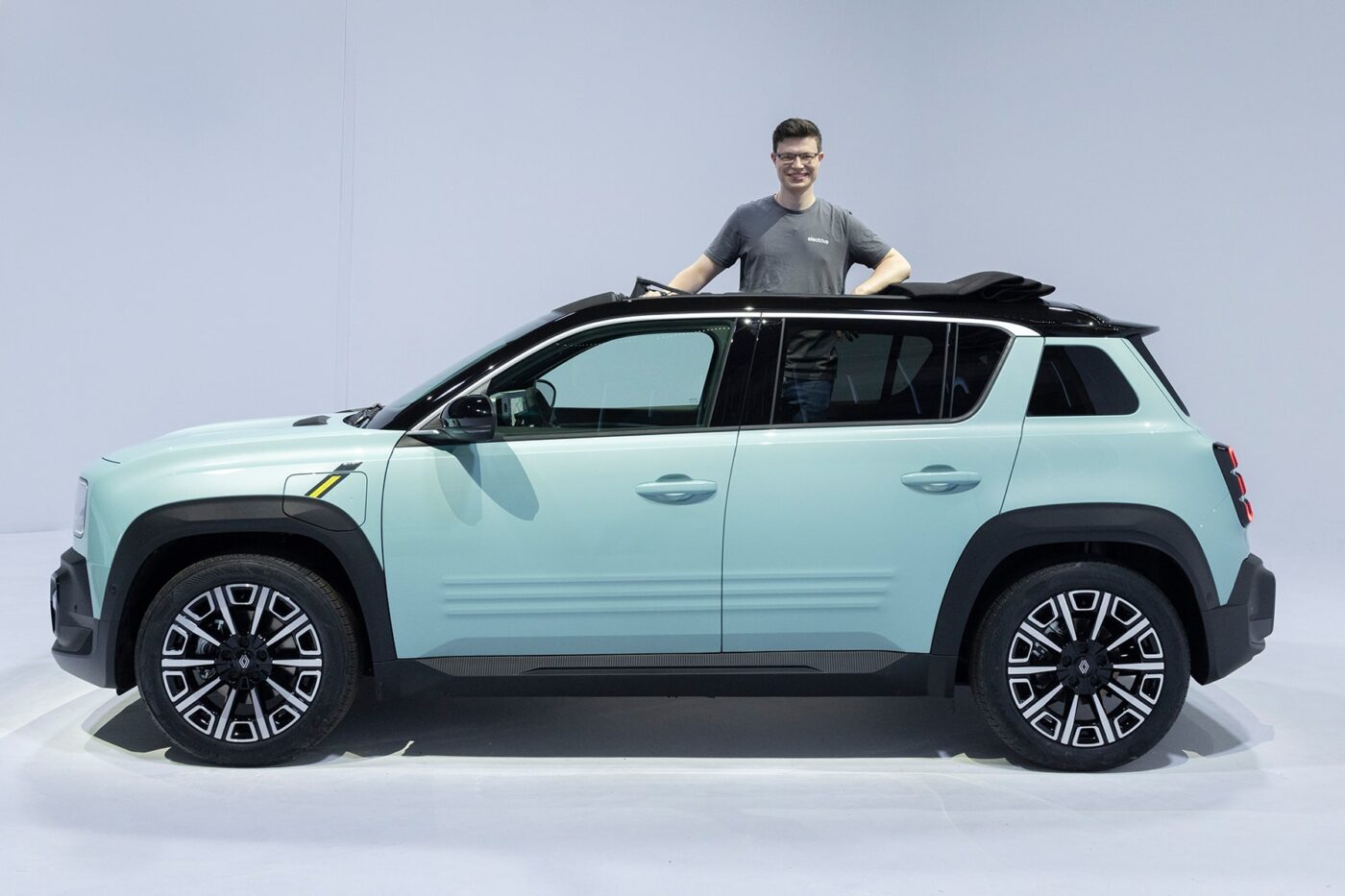
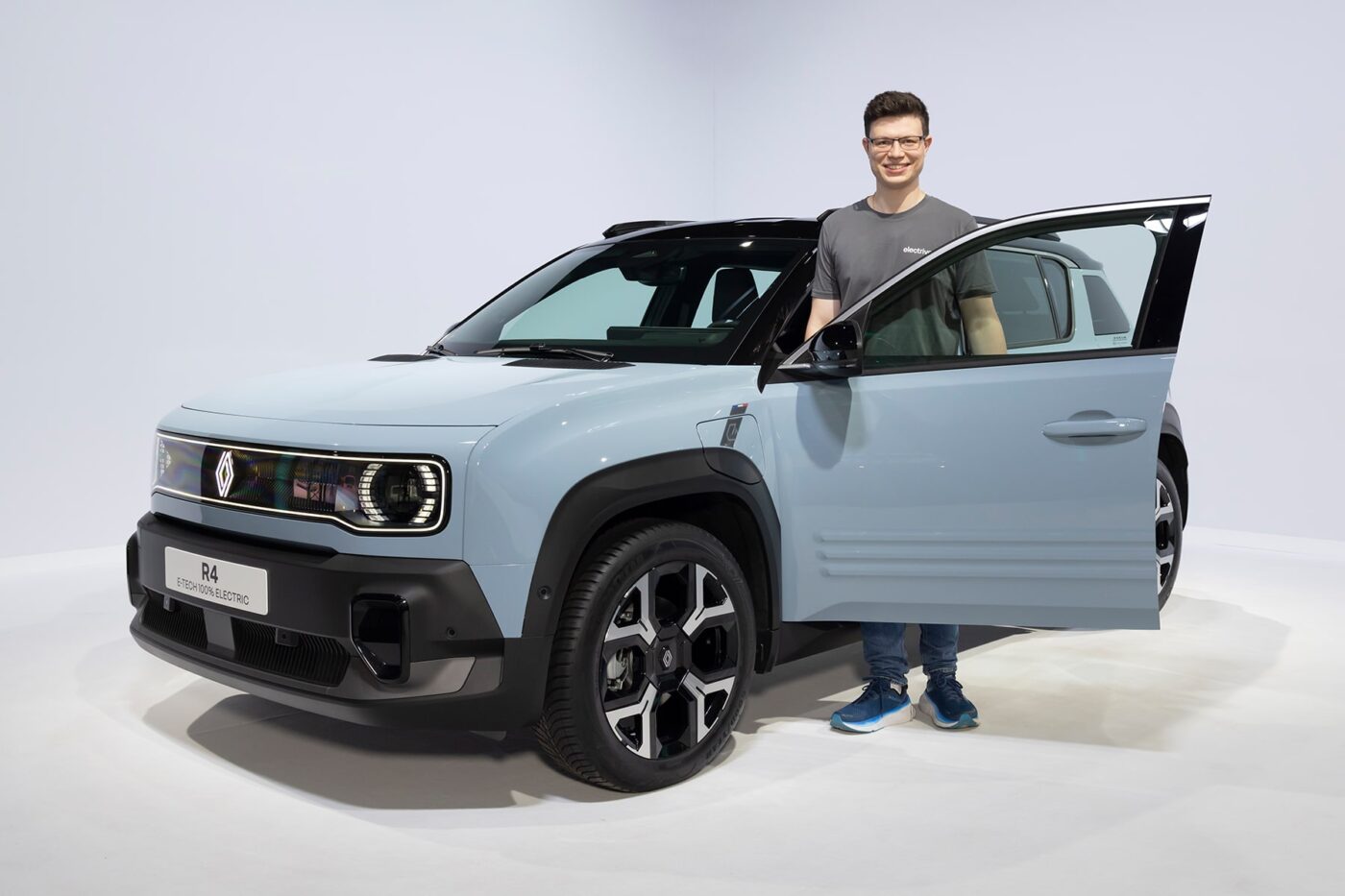
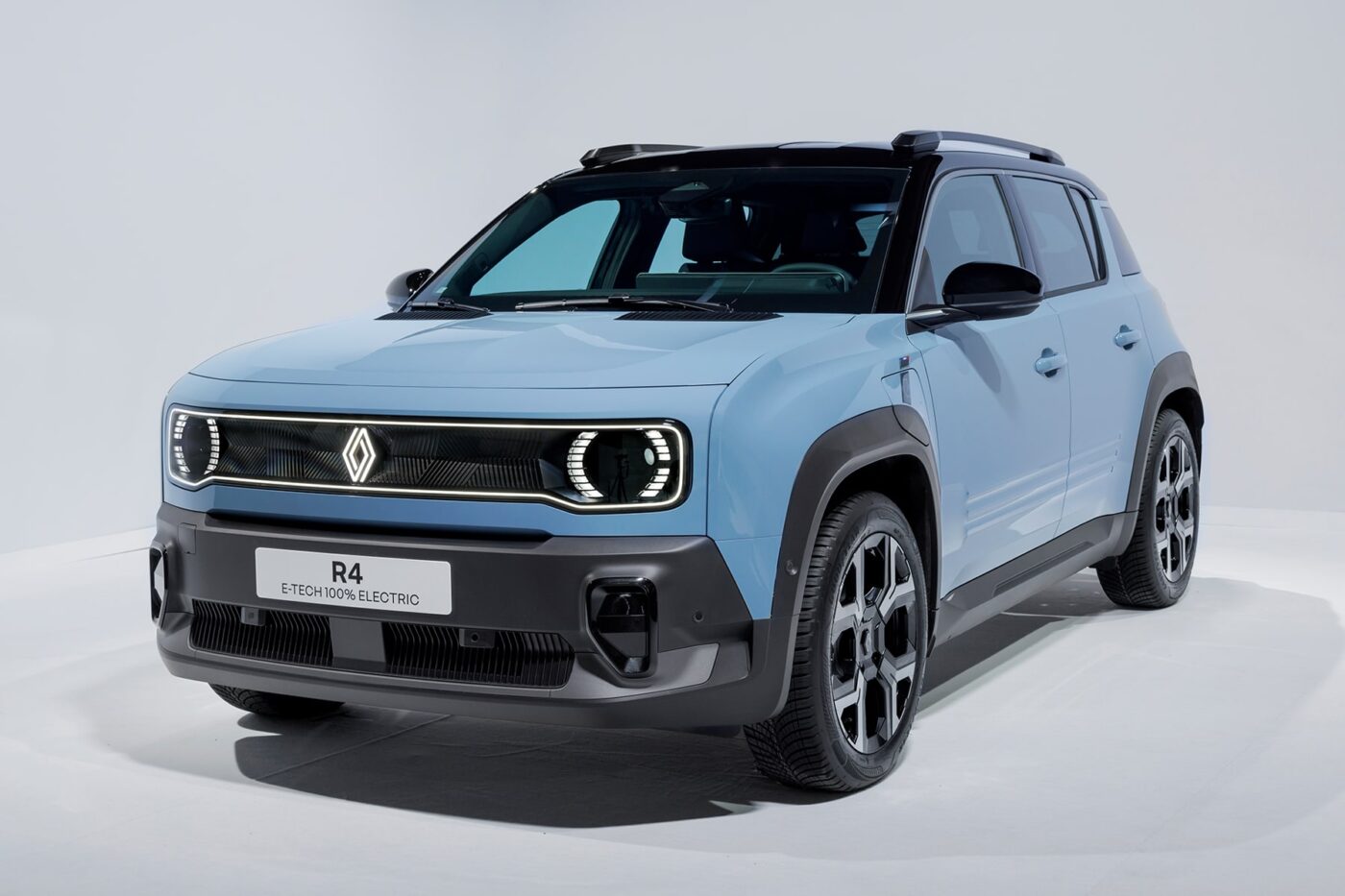
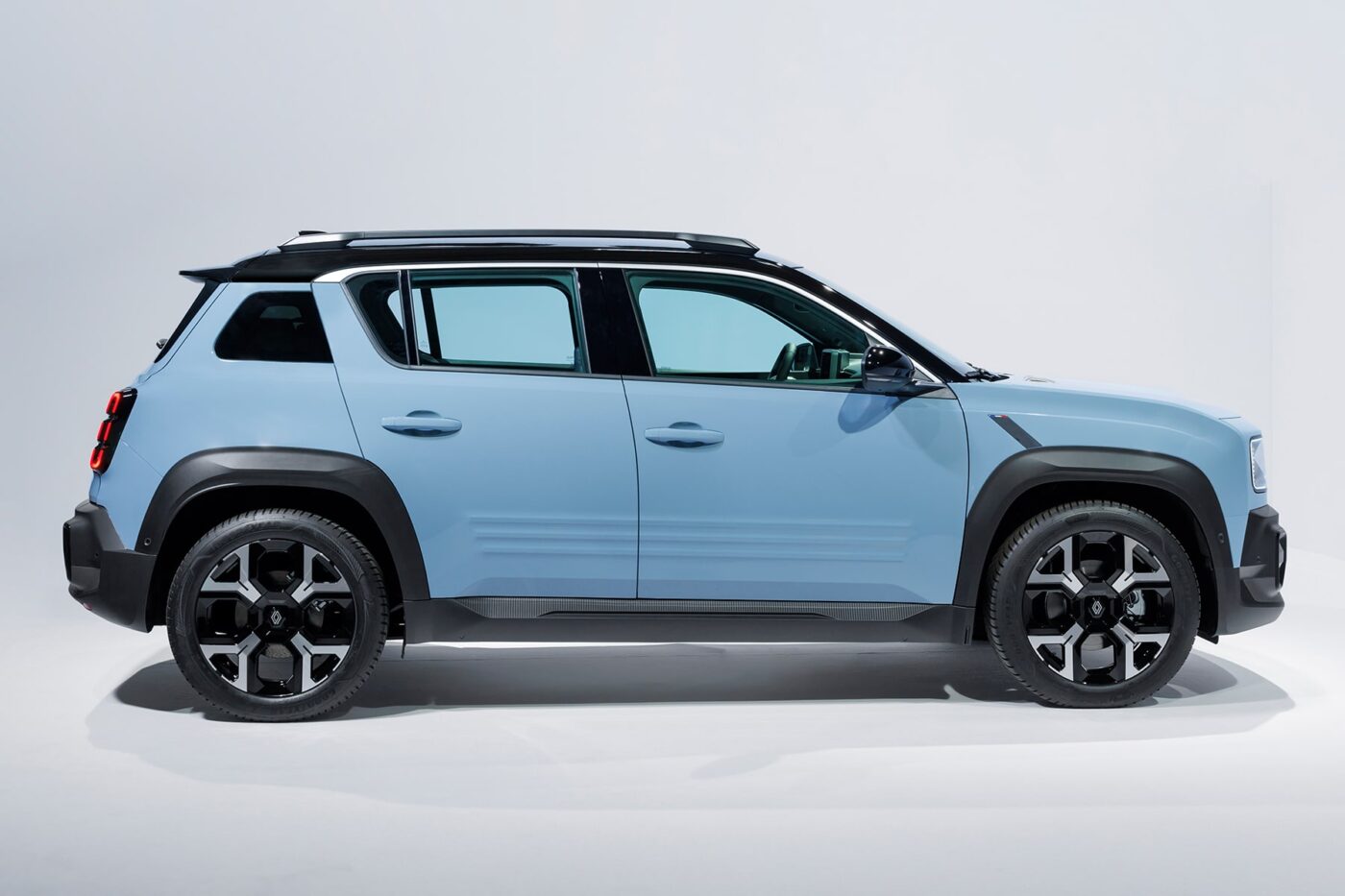
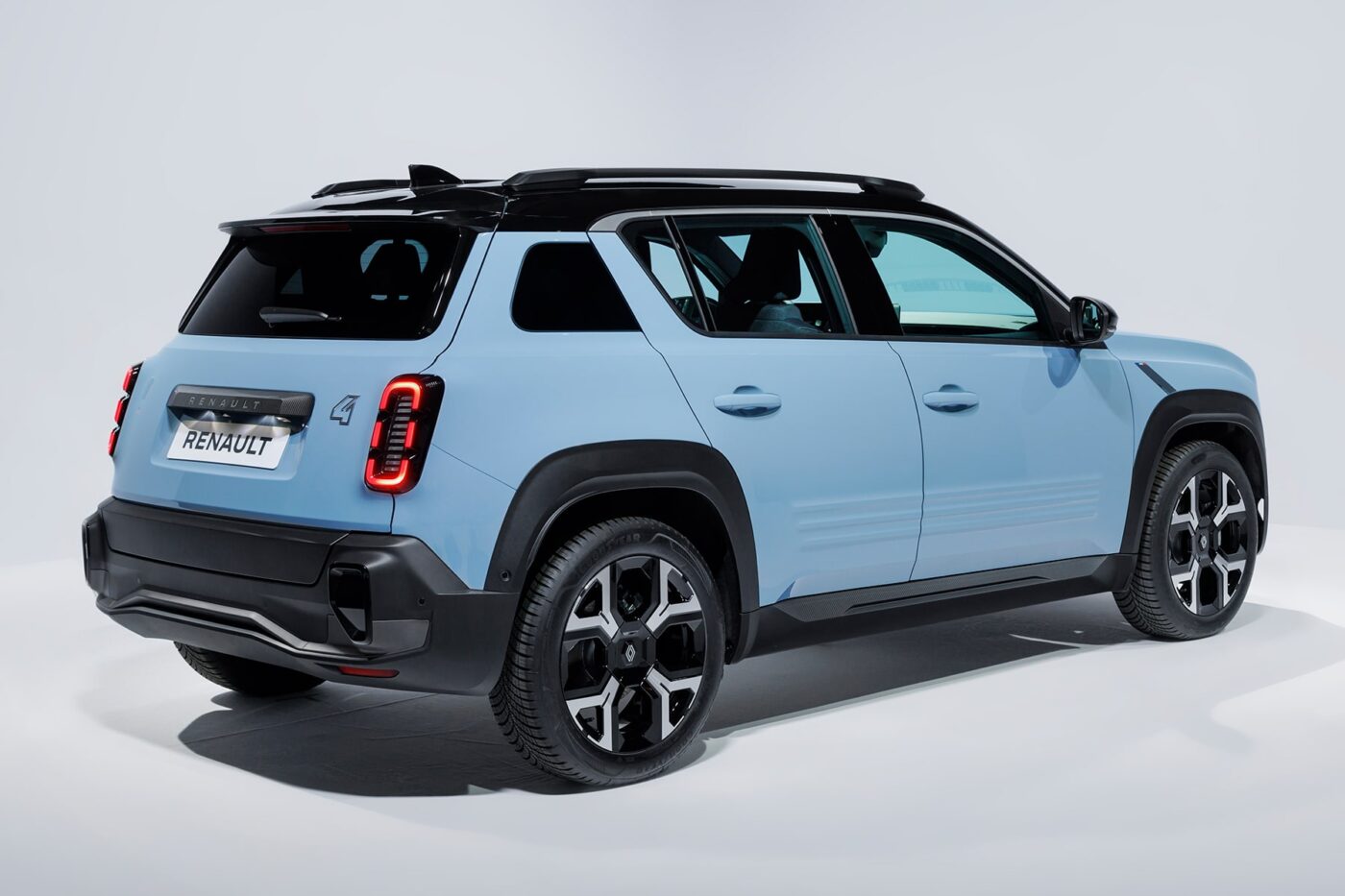
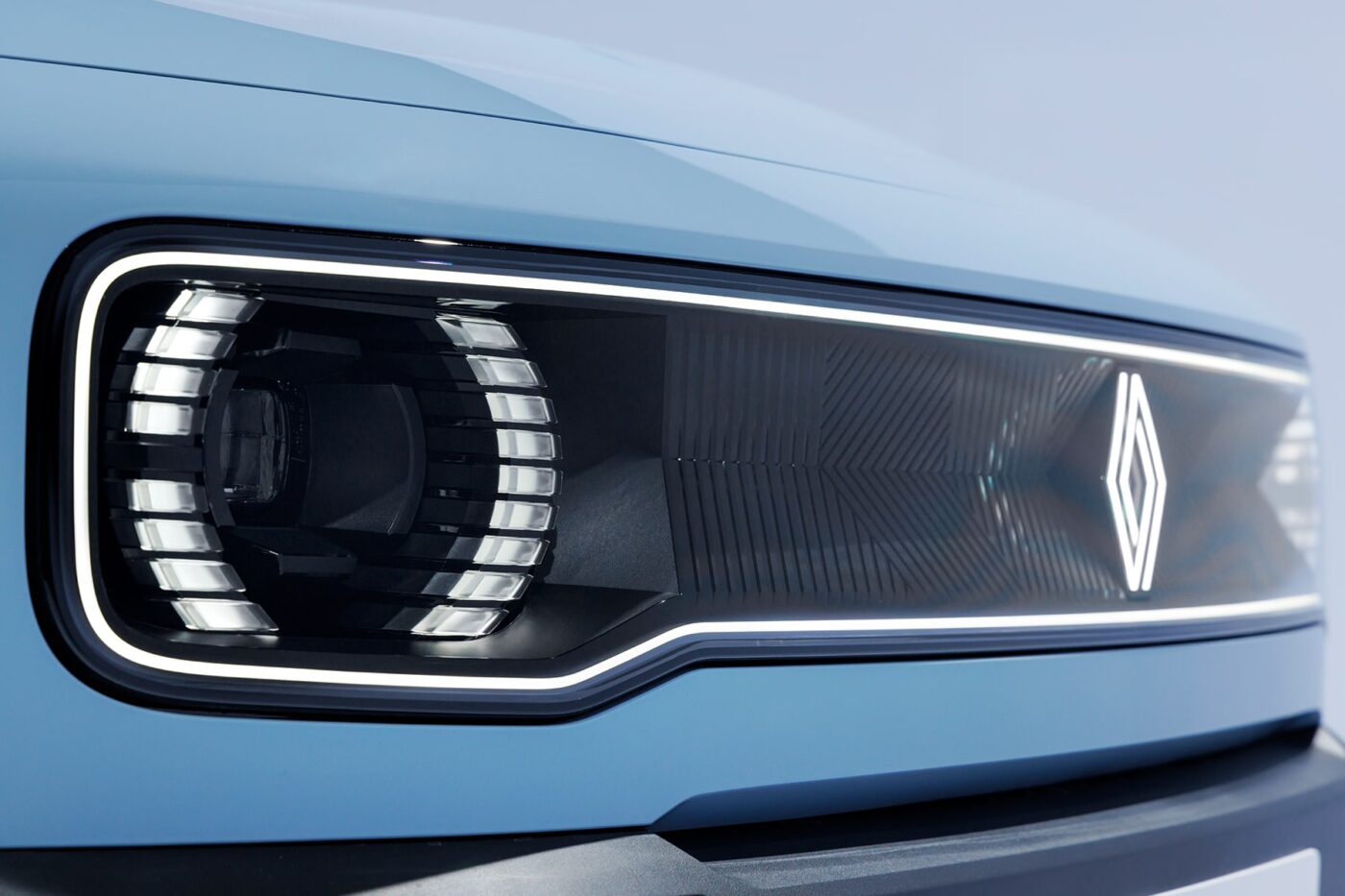
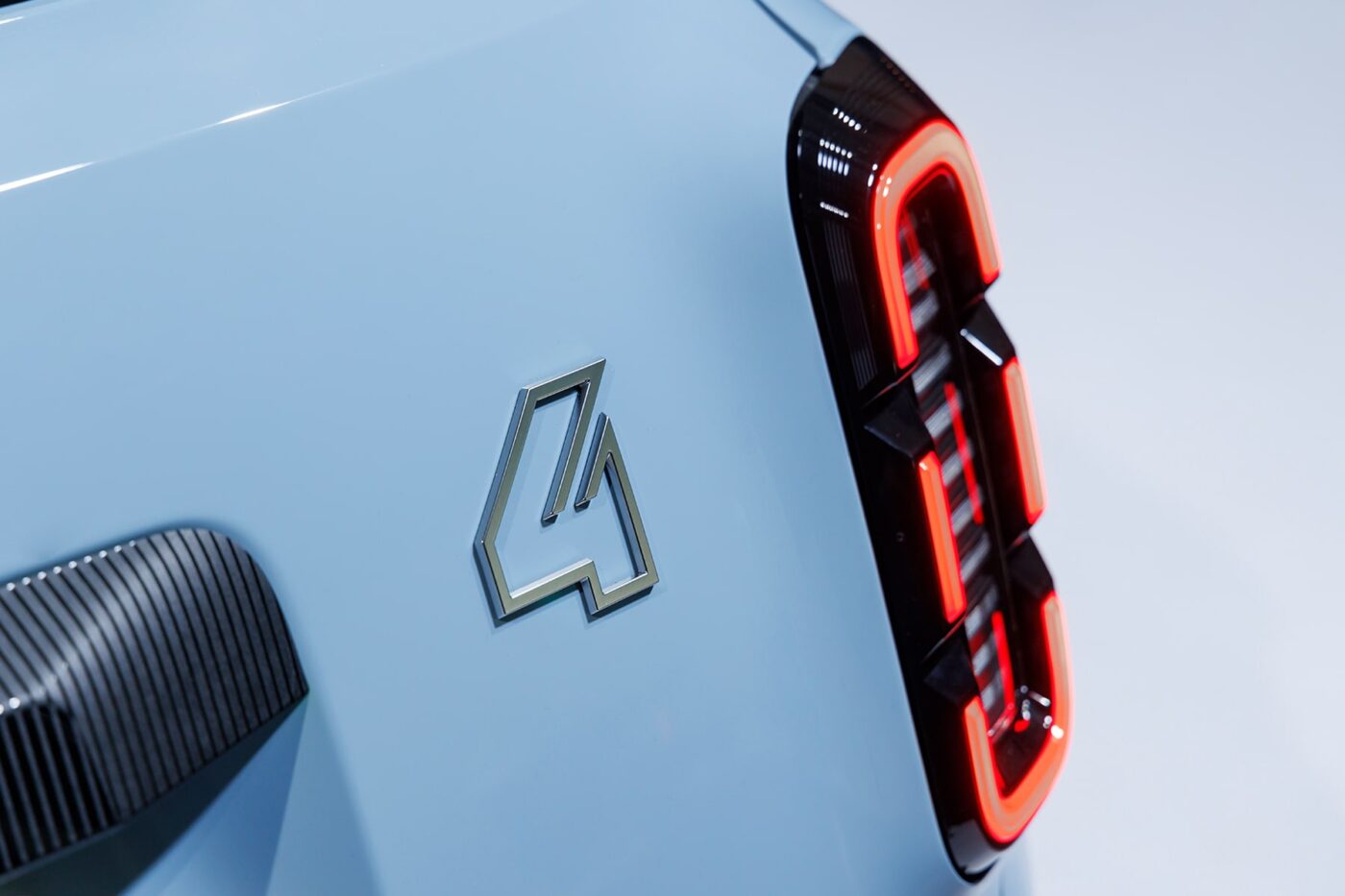
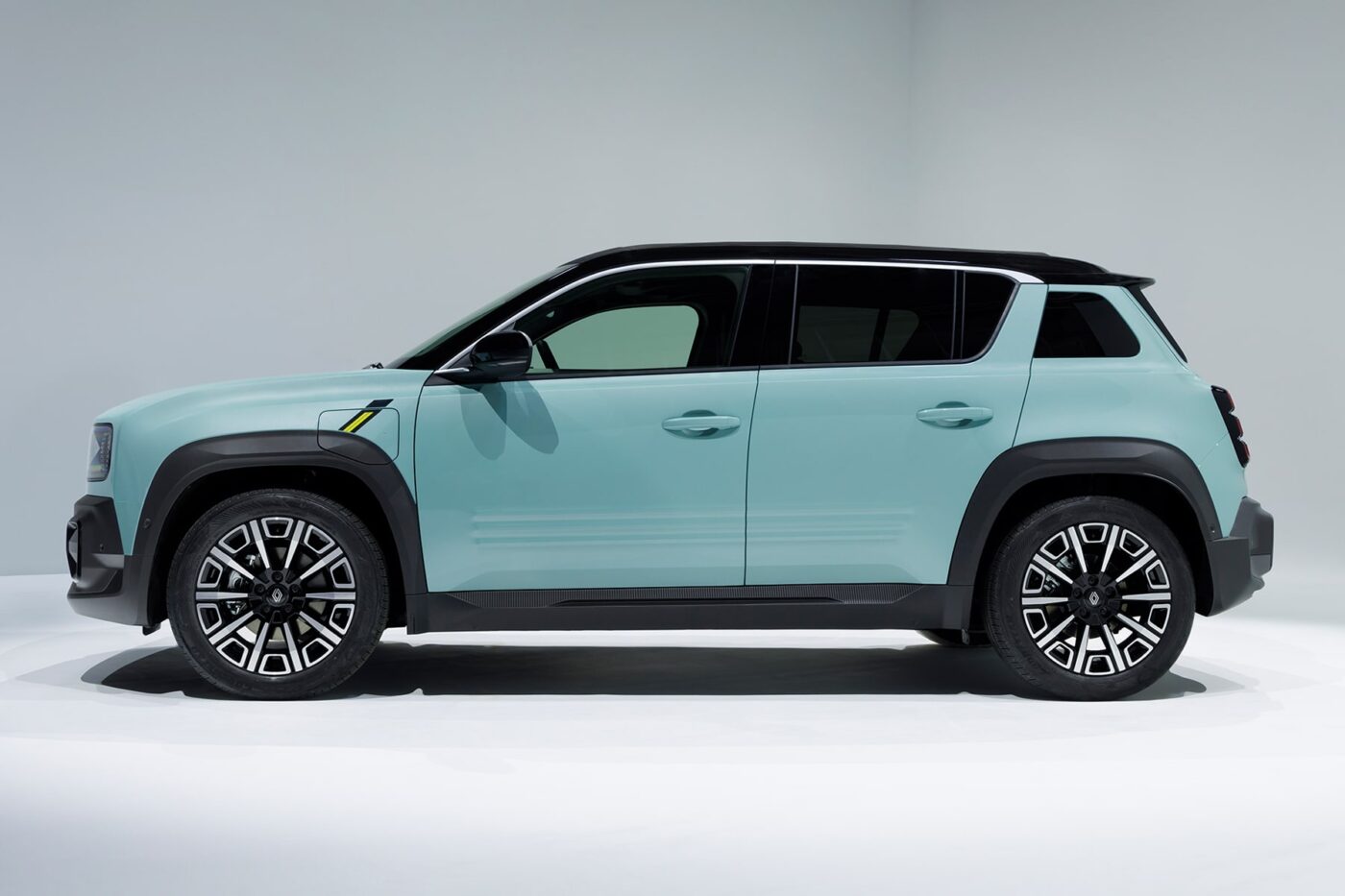
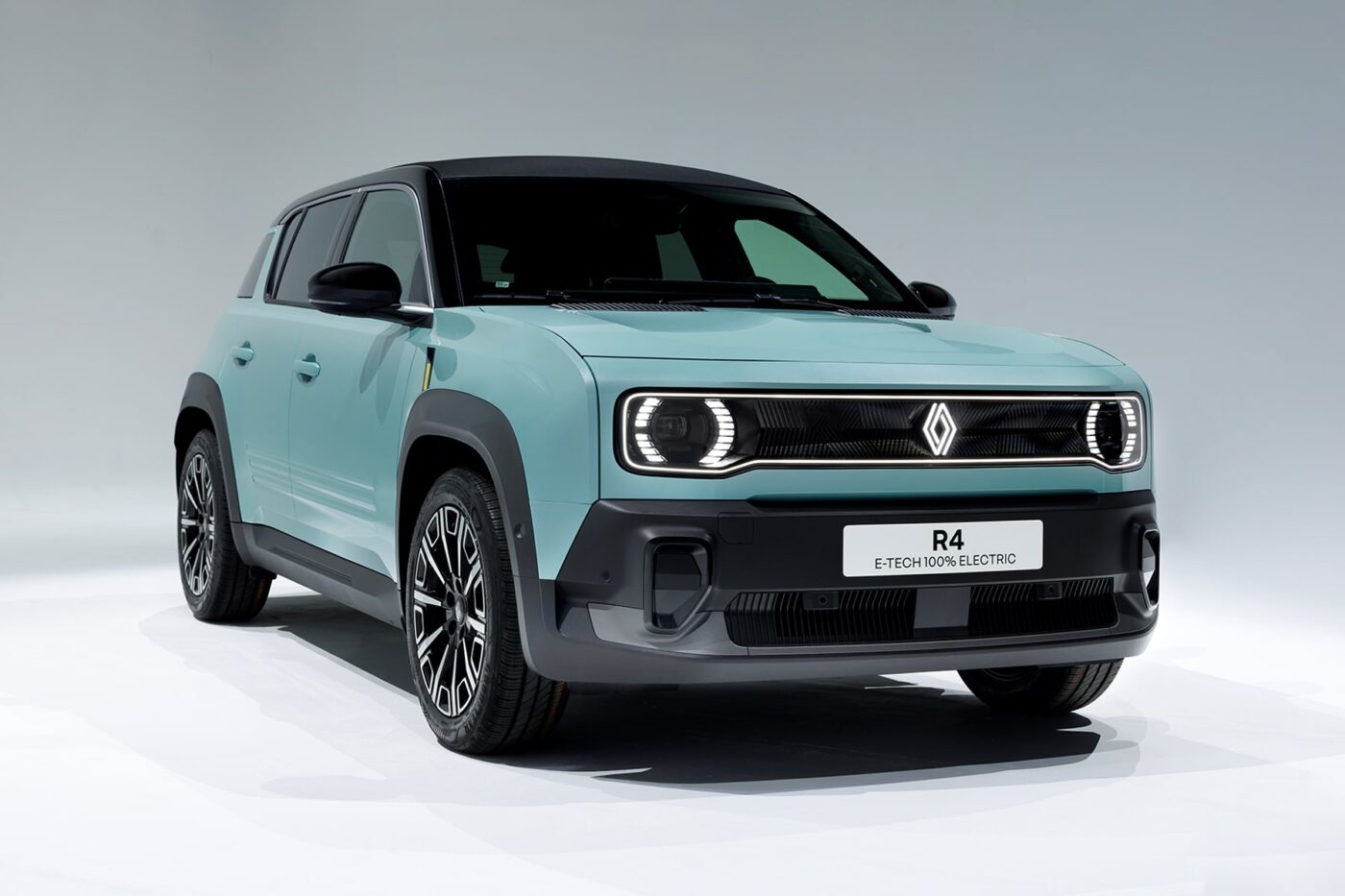
For one thing, there is the fabric sunroof, whose huge opening goes far beyond the dimensions of normal sunroofs and certainly creates a convertible feeling, as well as the plastic bumpers. In France, where parking is still considered a contact sport, painted bumpers are out of place, and flexible plastic is cheaper and easier on the nerves.
Almost everything done right on the inside
The R4 continues the homage to France in the interior with a baguette holder and other tricolours. Nobody needs that, but it makes the car somehow endearing.
At first glance, the leather dashboard provides a touch of high quality that you wouldn’t expect from Renault. That continues thanks to the part-leather seats and fabric-covered doors, but we cannot console the fact that the quality of workmanship could have been better in detail, and the use of hard plastic could have been more careful.
Unfortunately, the steering wheel is completely overloaded with four (!) steering column levers and 15 buttons (for cruise control, driving mode and infotainment); this range of functions could have been presented more logically. Nevertheless, it is commendable that the PRND lever has been moved to the steering column and no longer takes up space in the centre console. Unfortunately, this is still the case with many manufacturers. There is still a start/stop button, so we can’t expect a direct start when the brakes are pressed.
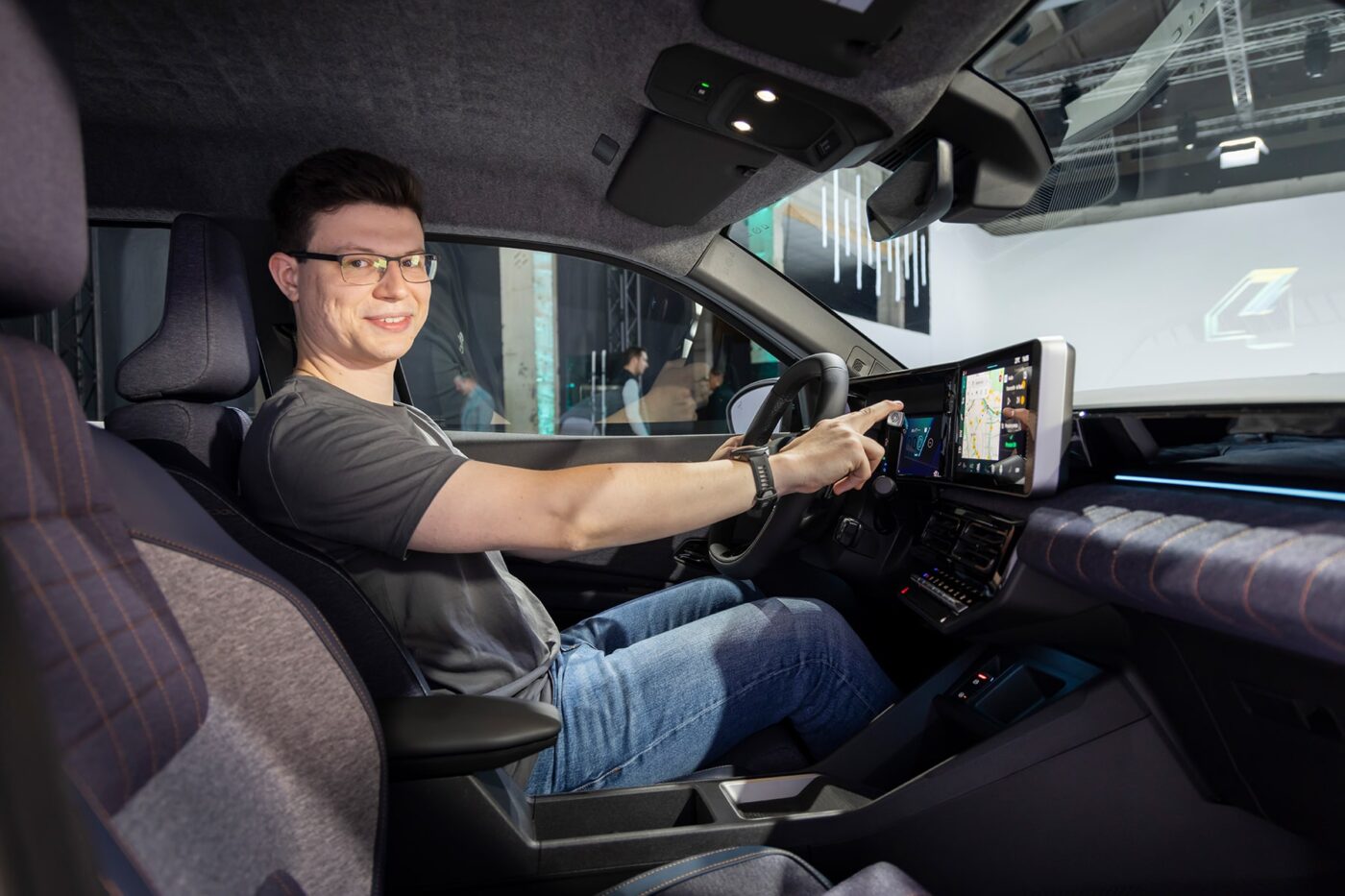
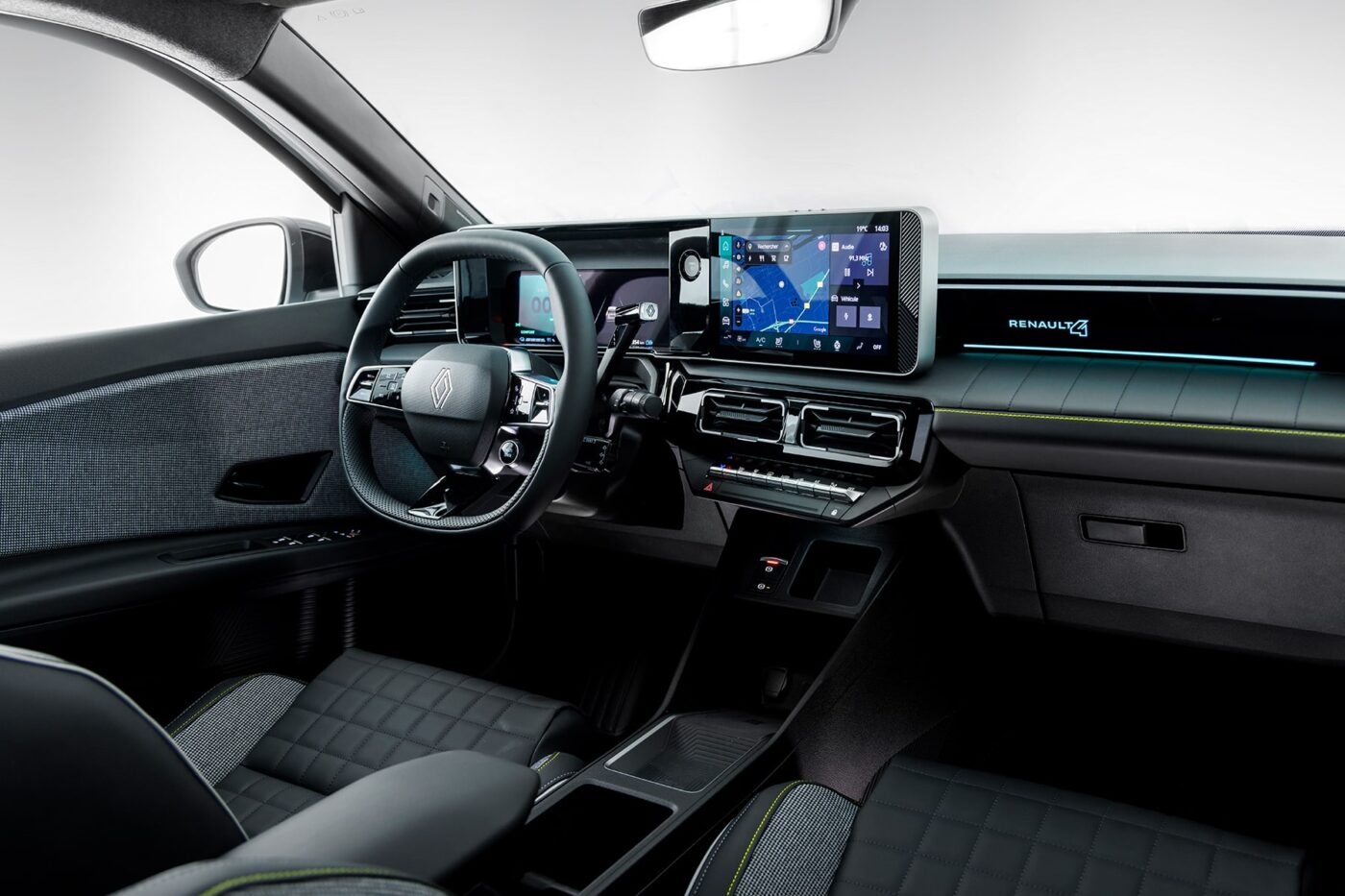
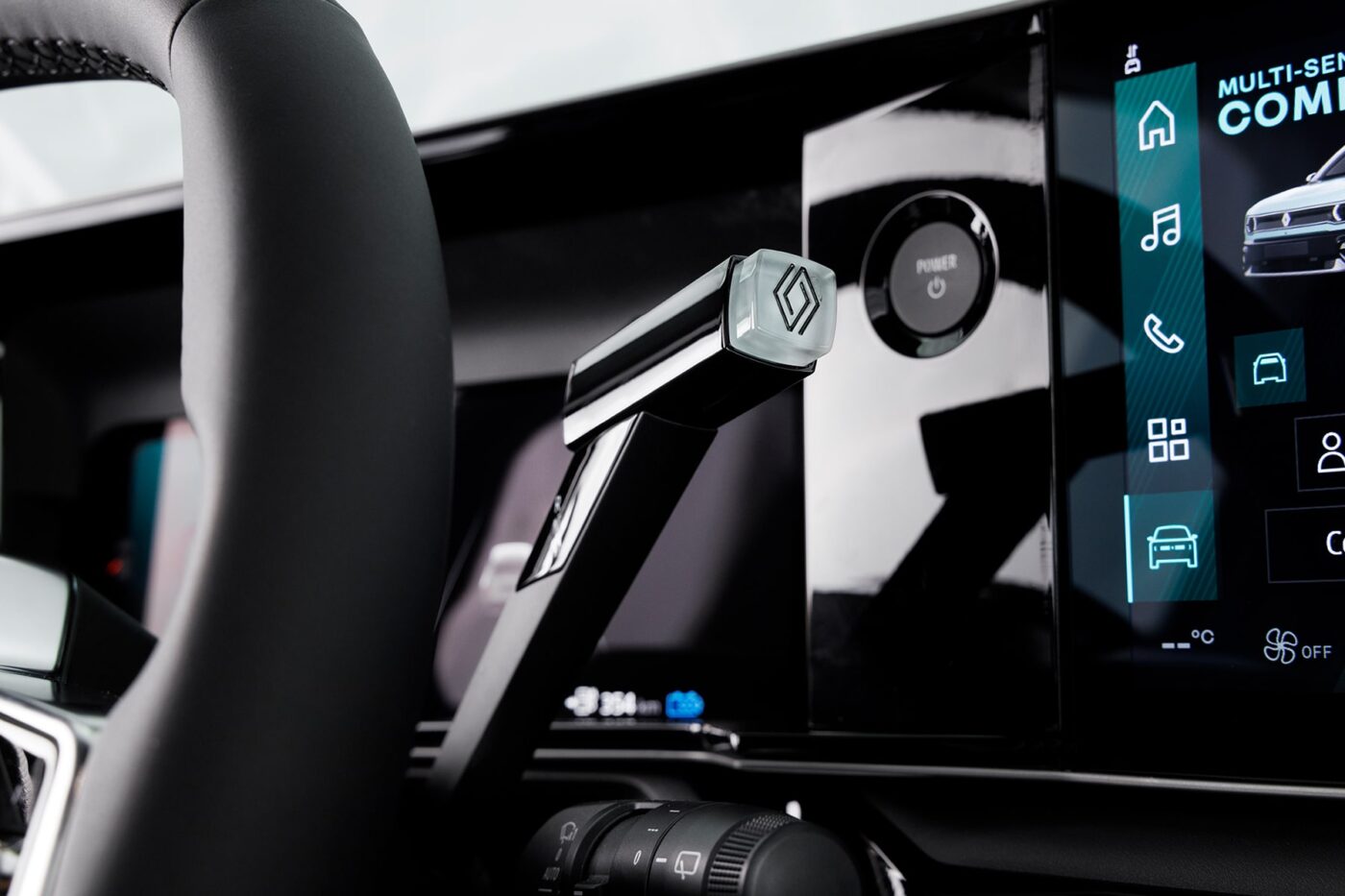
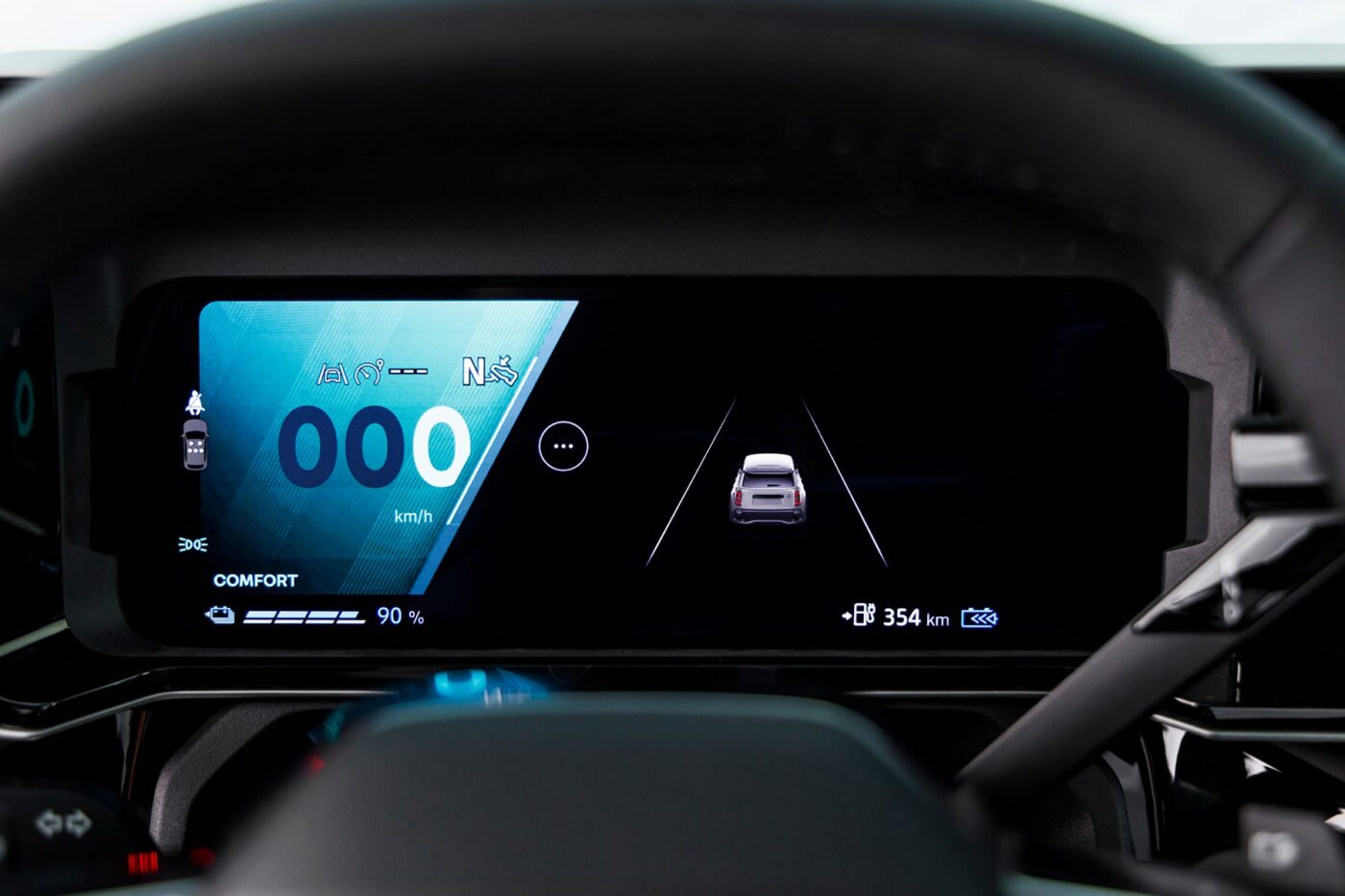
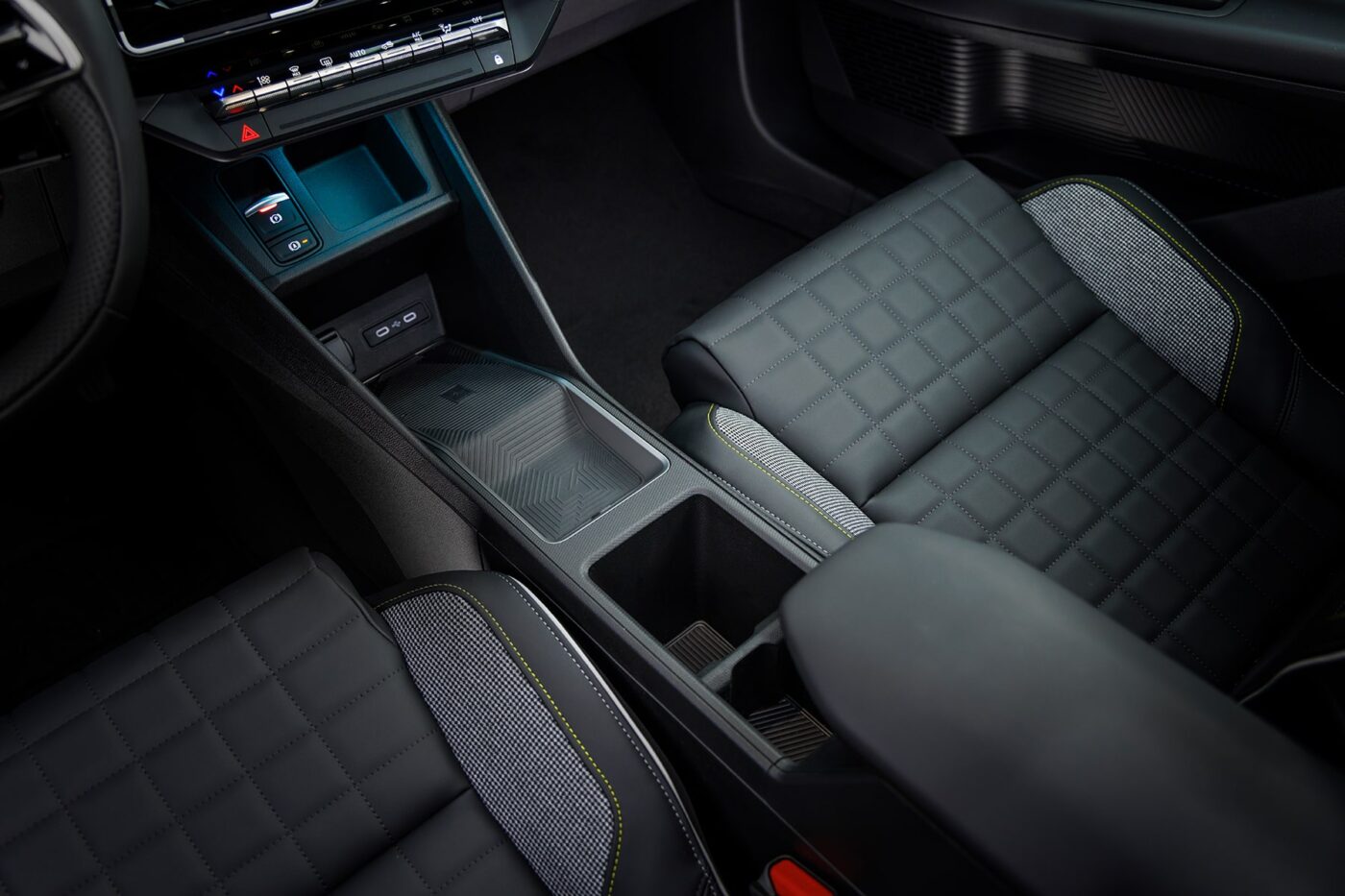
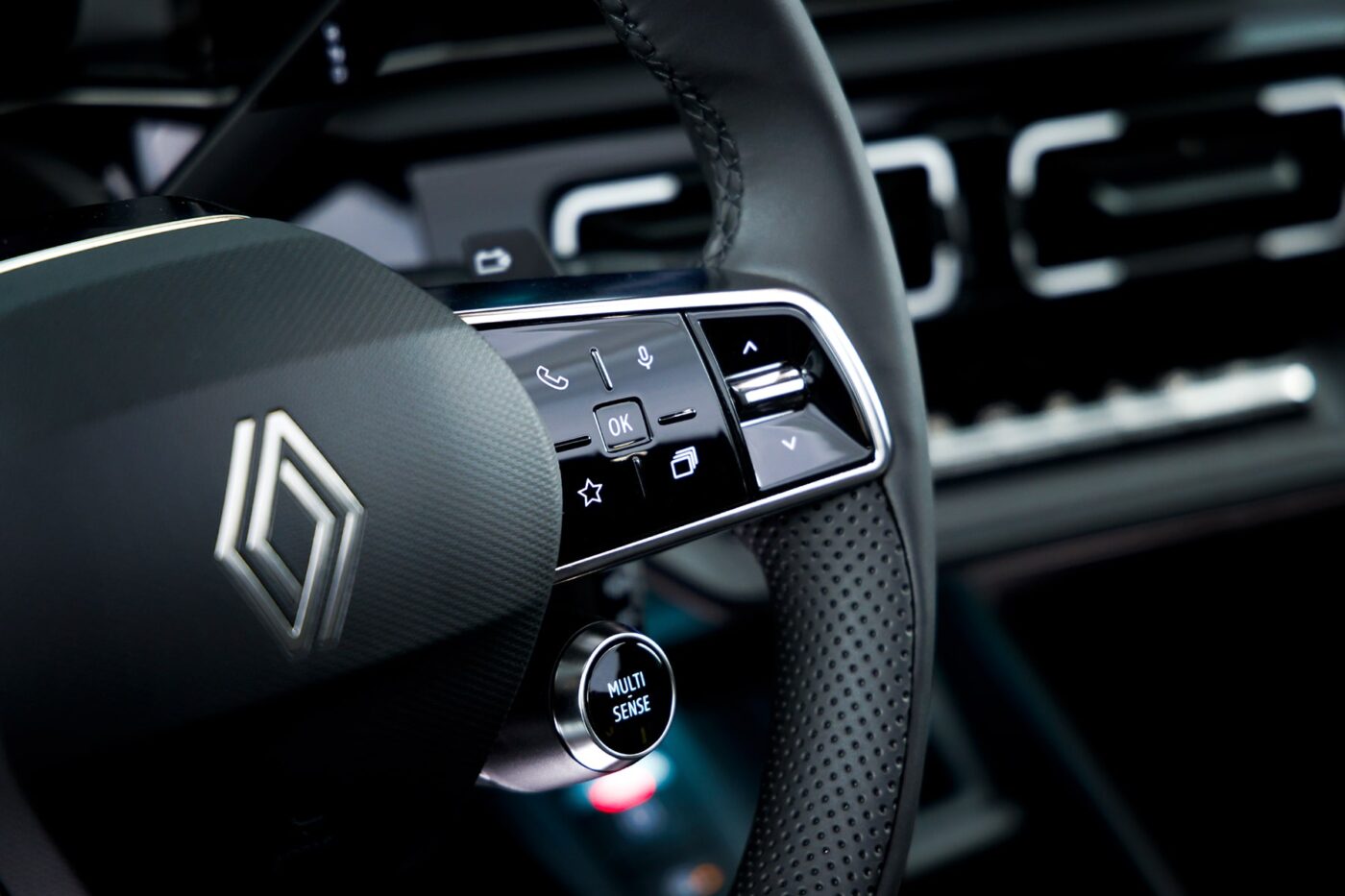
On the other hand, one-pedal-driving is finally available, in addition to three further recuperation levels that can be set using the shift paddles and an auto-hold function. Behind the steering wheel is a pleasingly large speedometer display, which can also show the sat nav map. Apart from the overcrowded steering wheel, Renault has balanced the number of buttons well: Not too many that it becomes confusing, but not so few that you have to spend ages searching the screen for the mirror or climate settings. Overall, the cockpit looks quite tidy, and the most essential functions are still easily accessible.
Four USB-C ports and an inductive charging tray supply the passengers’ smartphones with power. To prevent them from getting lost, smartphone pockets are sewn into the rear passengers’ front seats.
Google makes the software
Speaking of smartphones, the volume buttons on the central screen are reminiscent of the rocker switch on a modern mobile phone. It’s not intuitive to find at first, but in times when more and more manufacturers are shifting the volume control completely to the screen, it’s still commendable.
That also applies to the Android-based infotainment. Renault has realised that Google simply builds better user interfaces and consequently uses the Californians’ system. It runs quickly and smoothly, is logically structured, and allows access to a well-known variety of apps. E-route planning is in the capable hands of Google Maps.
In the settings, we discovered a variety of assistance systems, which admittedly could not be tested during a static premiere. These include automatic parking, autonomous driving level 2, driver monitoring and an emergency braking assistant. The only thing we missed was a 360-degree camera, but this will be added later.
Spacious in all seats
The amount of space for the occupants is impressive. There’s plenty of legroom in the front anyway, but we were really pleasantly surprised by the rear seat, which is surprisingly spacious for a vehicle of this size. If you adjust the driver and front passenger seats slightly higher, passengers can easily get their feet under the front seats, and there is plenty of legroom. There is also plenty of space at the top; the 1.80-metre tall editor still had plenty of room between his head and the roof.
There are only compromises in the seating position: the hips are a little too low and the knees a little too high – the usual space-saving trick. Nevertheless, the rear seats should be comfortable even on longer journeys, which is certainly better than in various competitor models. It also helps that there is no centre tunnel, not even a very small one for the wiring harness or similar – no, the floor is perfectly flat.
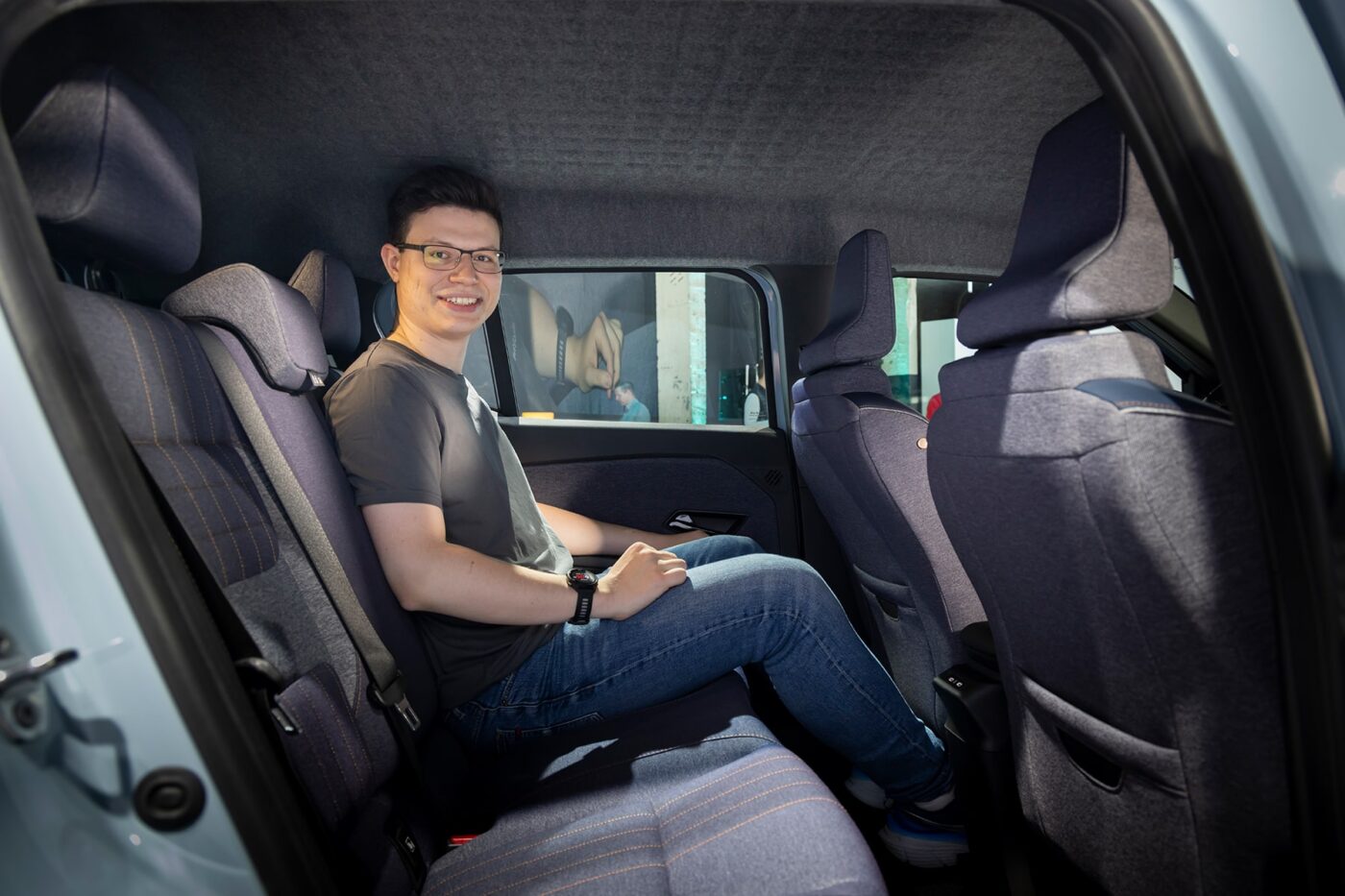
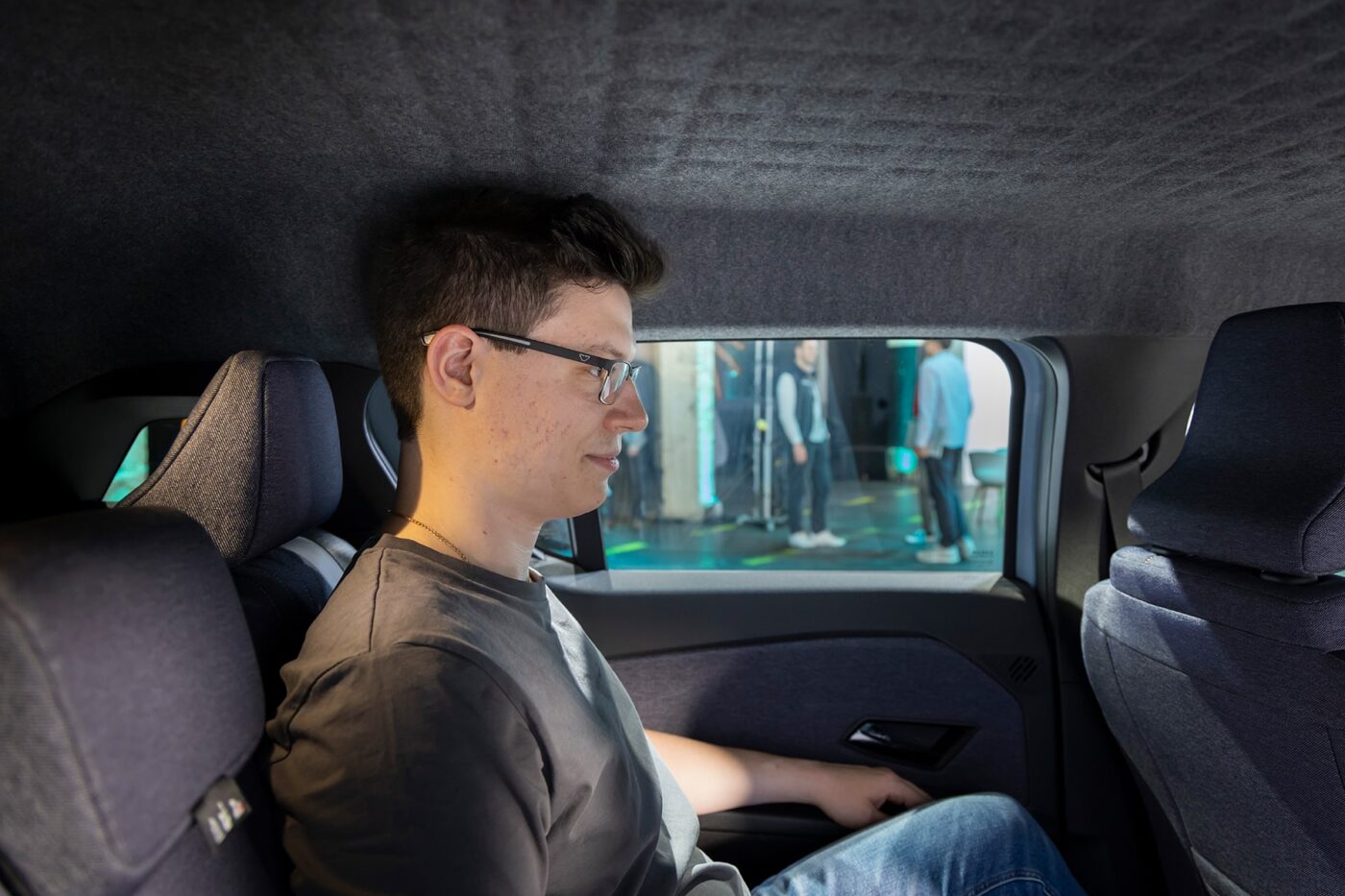
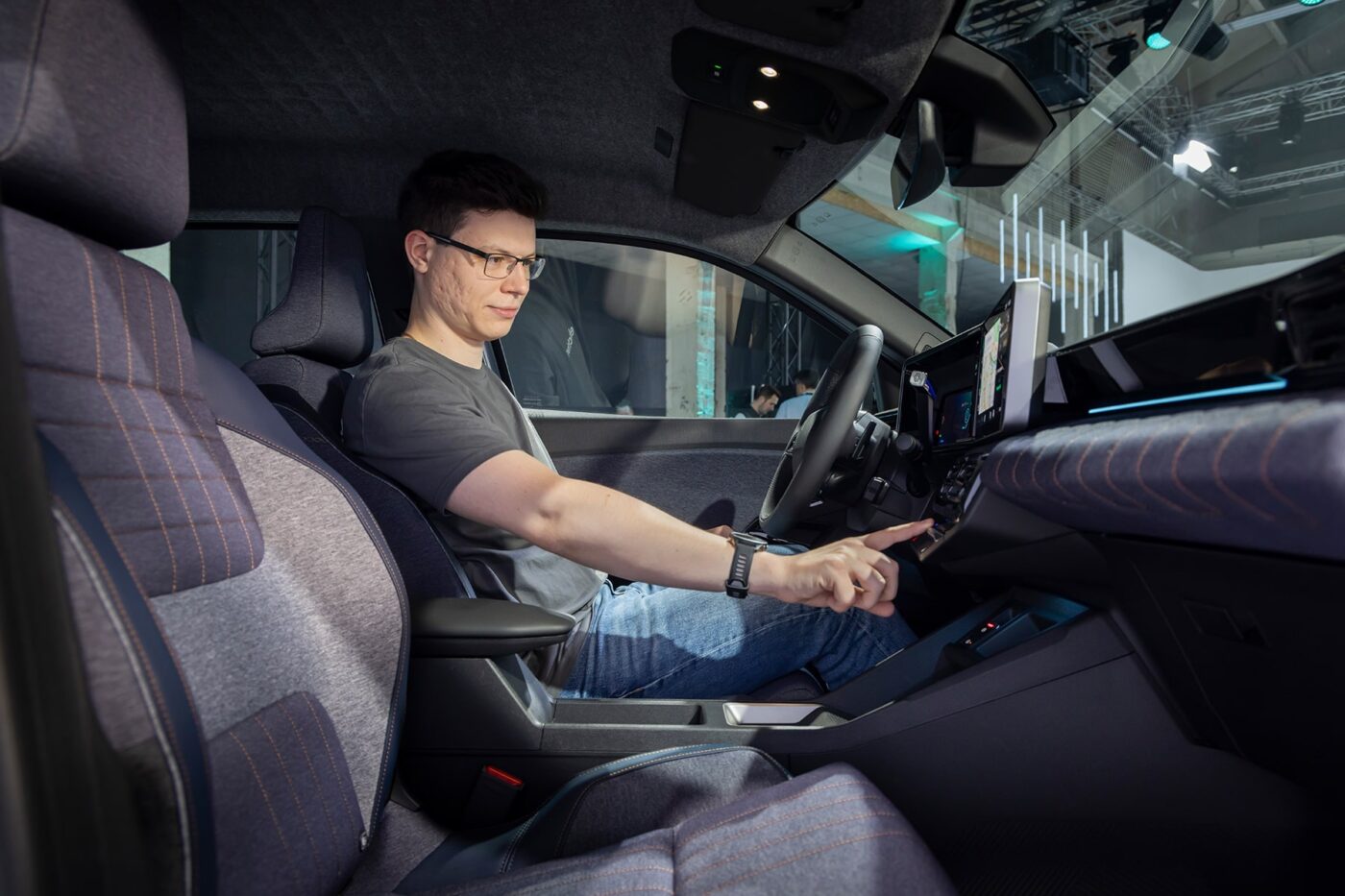
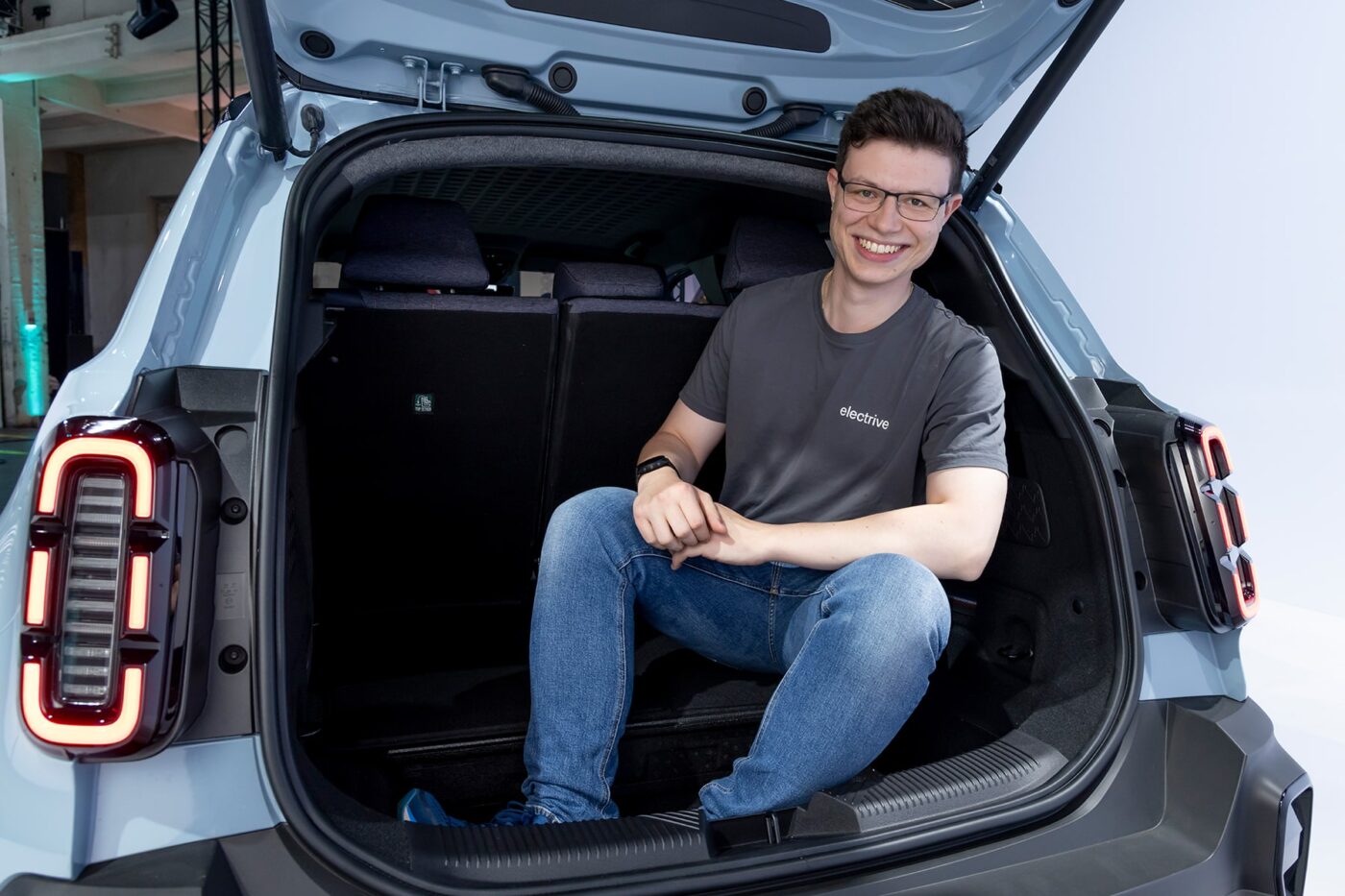
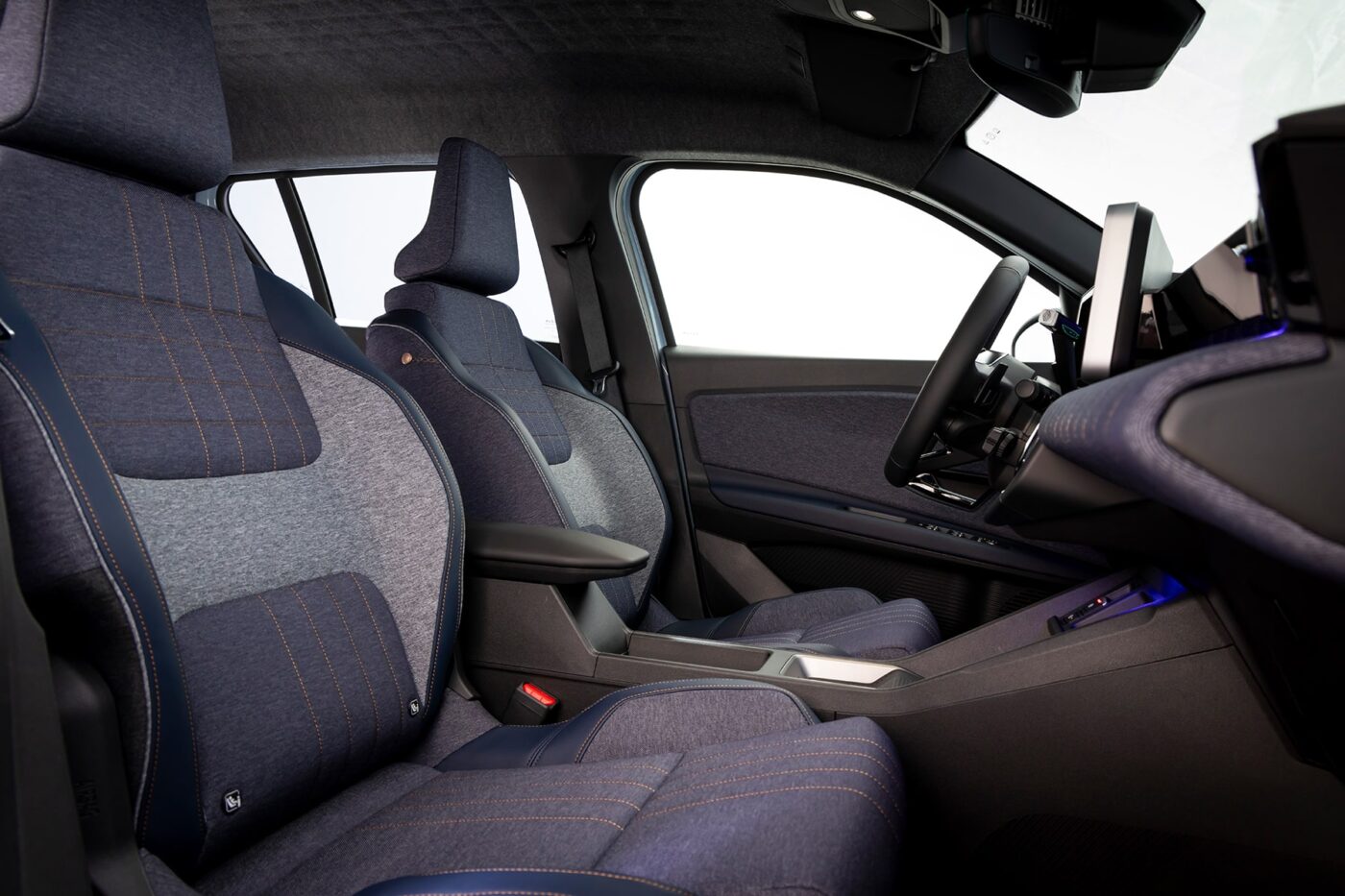
Three ISOFIX spaces are the icing on the cake, as more and more manufacturers are now only using two. It gives families more flexibility as to where they can attach the child seats.
Lots of room for luggage
The boot is surprisingly spacious for the size of the vehicle. An impressive 420 litres of load space is hidden behind the broad, electric tailgate, which is pleasantly straightforward and not too convoluted. Large holiday luggage fits in here easily, even a pushchair is no problem. The loading sill is comparatively low at 61 cm above road level. Thanks to the fold-down front seat, the maximum load-through length is a generous 2.20 metres, so there is plenty of room for long items. Renault demonstrates this with a surfboard during the première, but in everyday life, it is more likely to be an Ikea shelf that has to fit into the car somehow.
The more we walk around the car, the more a slogan comes to mind that has been coined by another car manufacturer: “Simply clever!” Because many details on the R4 are just that. For example, the basket for the underbody in the boot, where you can stow the charging cable, or extra side compartments for small items that shouldn’t fly around. We also noticed the stop button in the charging socket. It’s nothing special, but it’s often omitted in cheaper vehicles, which is annoying because it takes unnecessarily longer to end a charging process. It’s good that Renault has decided against this cost-saving measure.



The tow hitch also sets it apart from the competition, as until now, only significantly larger electric cars have been able to tow a trailer. Although 750 kg towing capacity is not generous, it is enough for bulk shopping at the DIY store or a mini caravan.
Mediocre charging performance
As good as the first impression of the interior and exterior is, the built-in technology from Renault’s ‘AmpR Small’ platform is unfortunately mixed. The basic version has a meagre 40-kWh battery, while the ‘large’ version offers 52 kWh. According to Renault, a larger battery is technically possible, but is not currently on the table. If the drive is efficient enough, this is still enough for a real-world range of over 300 kilometres, and the 90 or 110-kW drive power is also acceptable.
However, it is a real pity that the NMC batteries can only be charged with a maximum of 80 or 100 kW at the CCS fast charger. For most competitors, 150 kW is more common in this battery size range. So, while the R4 is well positioned in terms of loading space and passenger comfort, it is rather poor in terms of charging time. It puts a real damper on its suitability for long journeys – unnecessarily so.
Conclusion
The R4 is of a higher quality than the French competition from Peugeot or Citroen and, at the same time, has the charm that many newcomers from the Far East still lack. Whether this is enough to prevail against Tesla or Kia-Hyundai with mediocre performance data will largely depend on the price. Unfortunately, Renault is still keeping a lid on this, and we will probably only find out at the beginning of next year.



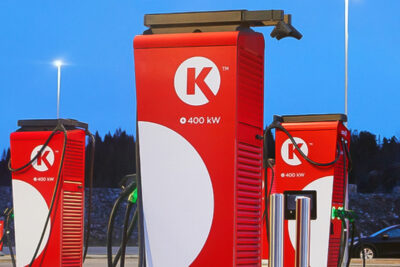
1 Comment